Criminology Essay: Incapacitation Theory and Race in British Prisons
VerifiedAdded on 2023/06/10
|7
|2419
|469
Essay
AI Summary
This essay delves into two key areas of criminology: incapacitation theory and the problem of racism within British prisons. The first section defines punishment and explores various theories, focusing on incapacitation, which involves restricting offenders' freedom to prevent further crime. The essay details the application of incapacitation, its advantages, and disadvantages, highlighting its role in reducing crime by directly controlling offenders. The second section addresses the issue of prison racism, examining the overrepresentation of ethnic minorities, particularly Black and Asian individuals, in British prisons. It discusses institutional racism, racial incidents involving inmates and staff, and the experiences of racial victimization. The essay emphasizes the need for revised race relation policies and further criminological research to address these critical issues.
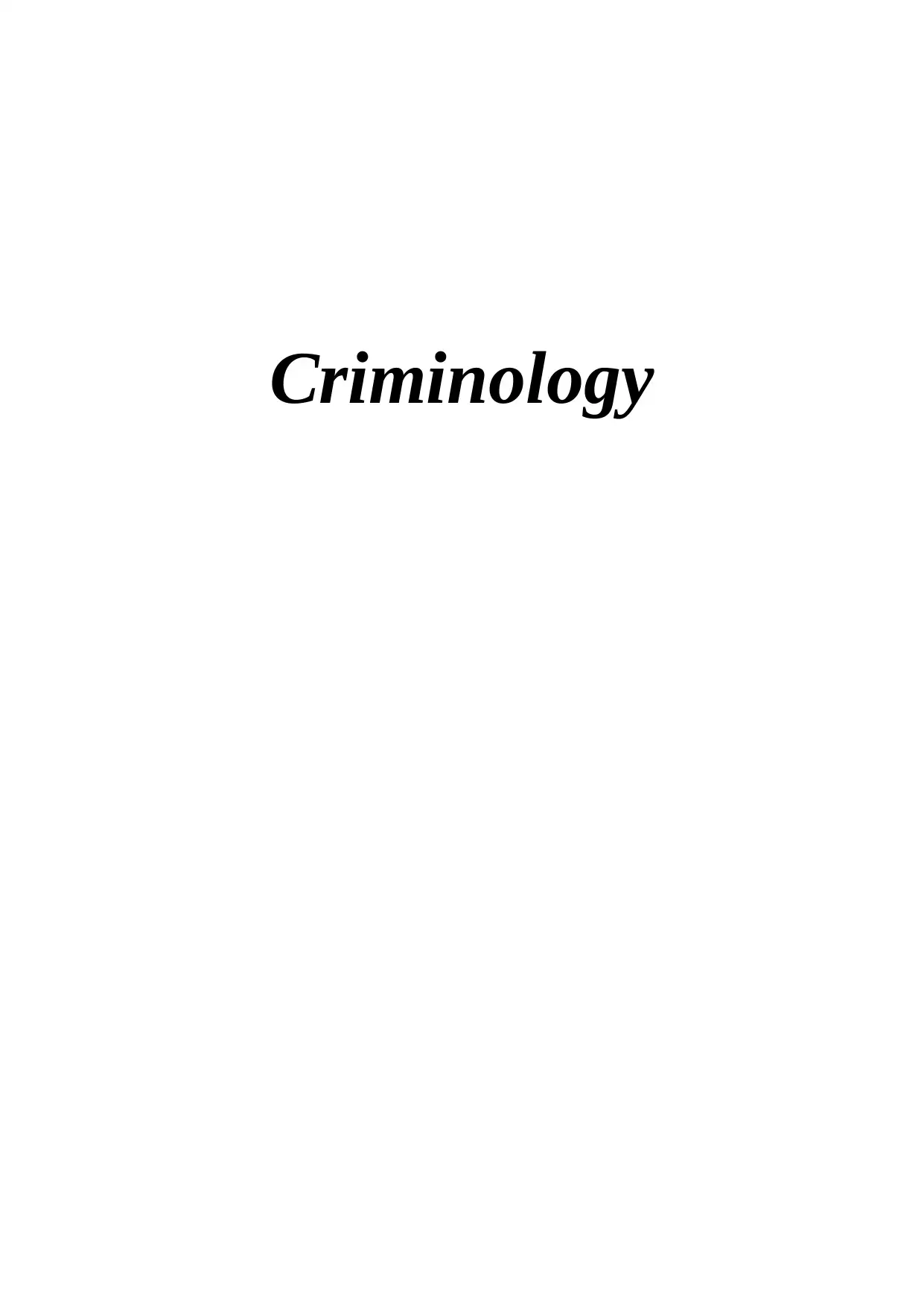
Criminology
Paraphrase This Document
Need a fresh take? Get an instant paraphrase of this document with our AI Paraphraser

Table of Contents
MAIN BODY.......................................................................................................................................3
Question 1........................................................................................................................................3
Question 2:.......................................................................................................................................4
REFERENCES.....................................................................................................................................7
MAIN BODY.......................................................................................................................................3
Question 1........................................................................................................................................3
Question 2:.......................................................................................................................................4
REFERENCES.....................................................................................................................................7
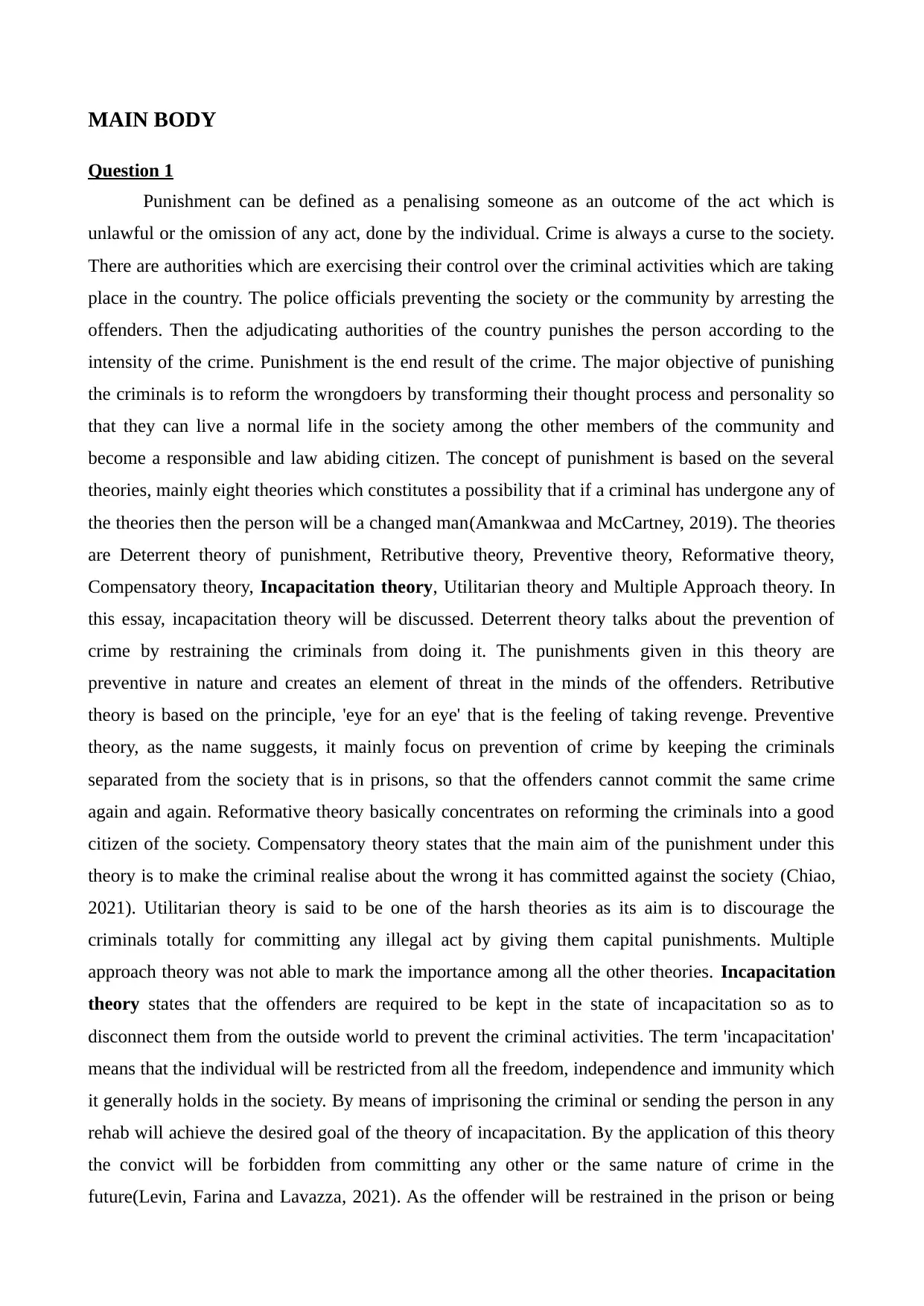
MAIN BODY
Question 1
Punishment can be defined as a penalising someone as an outcome of the act which is
unlawful or the omission of any act, done by the individual. Crime is always a curse to the society.
There are authorities which are exercising their control over the criminal activities which are taking
place in the country. The police officials preventing the society or the community by arresting the
offenders. Then the adjudicating authorities of the country punishes the person according to the
intensity of the crime. Punishment is the end result of the crime. The major objective of punishing
the criminals is to reform the wrongdoers by transforming their thought process and personality so
that they can live a normal life in the society among the other members of the community and
become a responsible and law abiding citizen. The concept of punishment is based on the several
theories, mainly eight theories which constitutes a possibility that if a criminal has undergone any of
the theories then the person will be a changed man(Amankwaa and McCartney, 2019). The theories
are Deterrent theory of punishment, Retributive theory, Preventive theory, Reformative theory,
Compensatory theory, Incapacitation theory, Utilitarian theory and Multiple Approach theory. In
this essay, incapacitation theory will be discussed. Deterrent theory talks about the prevention of
crime by restraining the criminals from doing it. The punishments given in this theory are
preventive in nature and creates an element of threat in the minds of the offenders. Retributive
theory is based on the principle, 'eye for an eye' that is the feeling of taking revenge. Preventive
theory, as the name suggests, it mainly focus on prevention of crime by keeping the criminals
separated from the society that is in prisons, so that the offenders cannot commit the same crime
again and again. Reformative theory basically concentrates on reforming the criminals into a good
citizen of the society. Compensatory theory states that the main aim of the punishment under this
theory is to make the criminal realise about the wrong it has committed against the society (Chiao,
2021). Utilitarian theory is said to be one of the harsh theories as its aim is to discourage the
criminals totally for committing any illegal act by giving them capital punishments. Multiple
approach theory was not able to mark the importance among all the other theories. Incapacitation
theory states that the offenders are required to be kept in the state of incapacitation so as to
disconnect them from the outside world to prevent the criminal activities. The term 'incapacitation'
means that the individual will be restricted from all the freedom, independence and immunity which
it generally holds in the society. By means of imprisoning the criminal or sending the person in any
rehab will achieve the desired goal of the theory of incapacitation. By the application of this theory
the convict will be forbidden from committing any other or the same nature of crime in the
future(Levin, Farina and Lavazza, 2021). As the offender will be restrained in the prison or being
Question 1
Punishment can be defined as a penalising someone as an outcome of the act which is
unlawful or the omission of any act, done by the individual. Crime is always a curse to the society.
There are authorities which are exercising their control over the criminal activities which are taking
place in the country. The police officials preventing the society or the community by arresting the
offenders. Then the adjudicating authorities of the country punishes the person according to the
intensity of the crime. Punishment is the end result of the crime. The major objective of punishing
the criminals is to reform the wrongdoers by transforming their thought process and personality so
that they can live a normal life in the society among the other members of the community and
become a responsible and law abiding citizen. The concept of punishment is based on the several
theories, mainly eight theories which constitutes a possibility that if a criminal has undergone any of
the theories then the person will be a changed man(Amankwaa and McCartney, 2019). The theories
are Deterrent theory of punishment, Retributive theory, Preventive theory, Reformative theory,
Compensatory theory, Incapacitation theory, Utilitarian theory and Multiple Approach theory. In
this essay, incapacitation theory will be discussed. Deterrent theory talks about the prevention of
crime by restraining the criminals from doing it. The punishments given in this theory are
preventive in nature and creates an element of threat in the minds of the offenders. Retributive
theory is based on the principle, 'eye for an eye' that is the feeling of taking revenge. Preventive
theory, as the name suggests, it mainly focus on prevention of crime by keeping the criminals
separated from the society that is in prisons, so that the offenders cannot commit the same crime
again and again. Reformative theory basically concentrates on reforming the criminals into a good
citizen of the society. Compensatory theory states that the main aim of the punishment under this
theory is to make the criminal realise about the wrong it has committed against the society (Chiao,
2021). Utilitarian theory is said to be one of the harsh theories as its aim is to discourage the
criminals totally for committing any illegal act by giving them capital punishments. Multiple
approach theory was not able to mark the importance among all the other theories. Incapacitation
theory states that the offenders are required to be kept in the state of incapacitation so as to
disconnect them from the outside world to prevent the criminal activities. The term 'incapacitation'
means that the individual will be restricted from all the freedom, independence and immunity which
it generally holds in the society. By means of imprisoning the criminal or sending the person in any
rehab will achieve the desired goal of the theory of incapacitation. By the application of this theory
the convict will be forbidden from committing any other or the same nature of crime in the
future(Levin, Farina and Lavazza, 2021). As the offender will be restrained in the prison or being
⊘ This is a preview!⊘
Do you want full access?
Subscribe today to unlock all pages.

Trusted by 1+ million students worldwide
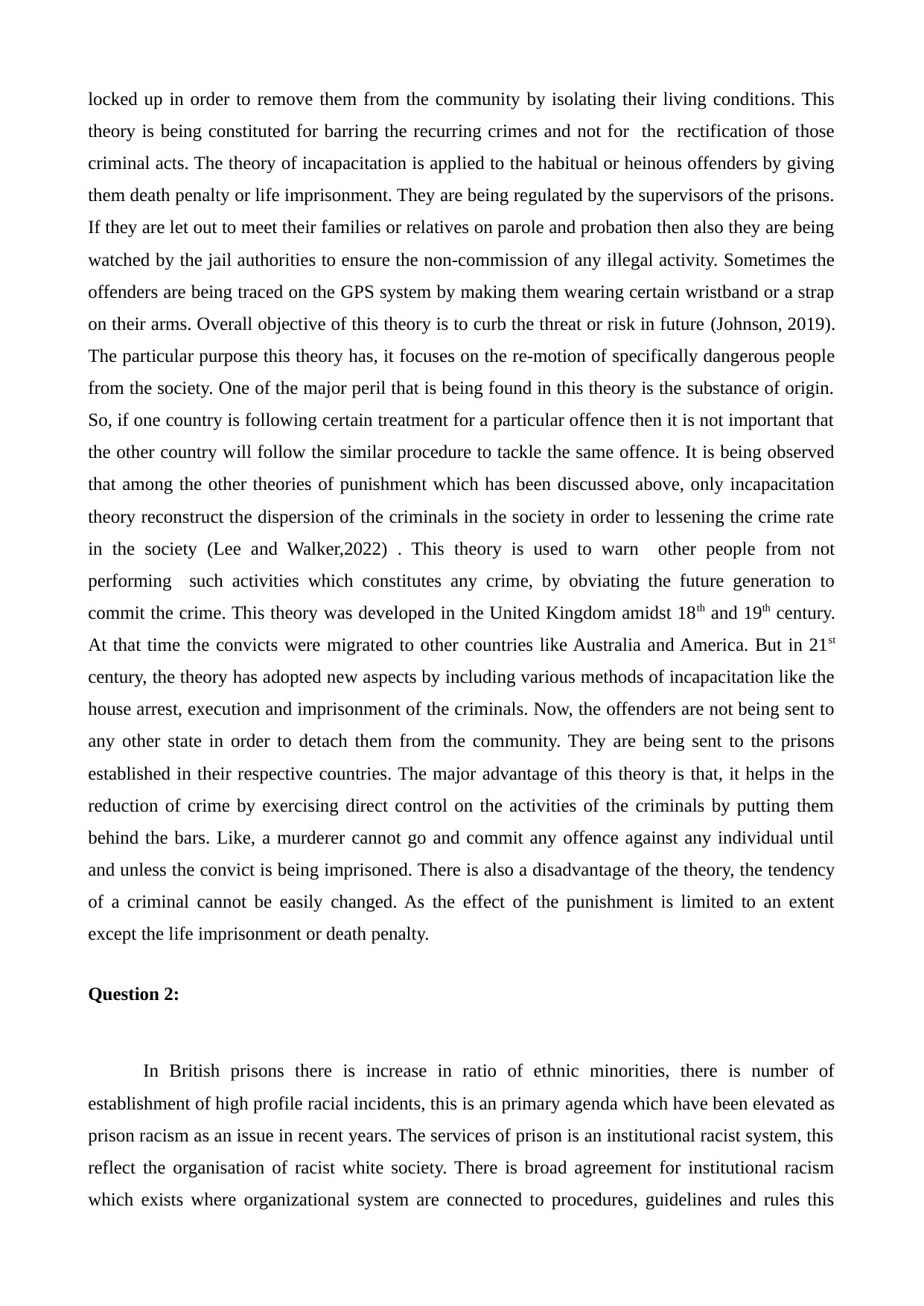
locked up in order to remove them from the community by isolating their living conditions. This
theory is being constituted for barring the recurring crimes and not for the rectification of those
criminal acts. The theory of incapacitation is applied to the habitual or heinous offenders by giving
them death penalty or life imprisonment. They are being regulated by the supervisors of the prisons.
If they are let out to meet their families or relatives on parole and probation then also they are being
watched by the jail authorities to ensure the non-commission of any illegal activity. Sometimes the
offenders are being traced on the GPS system by making them wearing certain wristband or a strap
on their arms. Overall objective of this theory is to curb the threat or risk in future (Johnson, 2019).
The particular purpose this theory has, it focuses on the re-motion of specifically dangerous people
from the society. One of the major peril that is being found in this theory is the substance of origin.
So, if one country is following certain treatment for a particular offence then it is not important that
the other country will follow the similar procedure to tackle the same offence. It is being observed
that among the other theories of punishment which has been discussed above, only incapacitation
theory reconstruct the dispersion of the criminals in the society in order to lessening the crime rate
in the society (Lee and Walker,2022) . This theory is used to warn other people from not
performing such activities which constitutes any crime, by obviating the future generation to
commit the crime. This theory was developed in the United Kingdom amidst 18th and 19th century.
At that time the convicts were migrated to other countries like Australia and America. But in 21st
century, the theory has adopted new aspects by including various methods of incapacitation like the
house arrest, execution and imprisonment of the criminals. Now, the offenders are not being sent to
any other state in order to detach them from the community. They are being sent to the prisons
established in their respective countries. The major advantage of this theory is that, it helps in the
reduction of crime by exercising direct control on the activities of the criminals by putting them
behind the bars. Like, a murderer cannot go and commit any offence against any individual until
and unless the convict is being imprisoned. There is also a disadvantage of the theory, the tendency
of a criminal cannot be easily changed. As the effect of the punishment is limited to an extent
except the life imprisonment or death penalty.
Question 2:
In British prisons there is increase in ratio of ethnic minorities, there is number of
establishment of high profile racial incidents, this is an primary agenda which have been elevated as
prison racism as an issue in recent years. The services of prison is an institutional racist system, this
reflect the organisation of racist white society. There is broad agreement for institutional racism
which exists where organizational system are connected to procedures, guidelines and rules this
theory is being constituted for barring the recurring crimes and not for the rectification of those
criminal acts. The theory of incapacitation is applied to the habitual or heinous offenders by giving
them death penalty or life imprisonment. They are being regulated by the supervisors of the prisons.
If they are let out to meet their families or relatives on parole and probation then also they are being
watched by the jail authorities to ensure the non-commission of any illegal activity. Sometimes the
offenders are being traced on the GPS system by making them wearing certain wristband or a strap
on their arms. Overall objective of this theory is to curb the threat or risk in future (Johnson, 2019).
The particular purpose this theory has, it focuses on the re-motion of specifically dangerous people
from the society. One of the major peril that is being found in this theory is the substance of origin.
So, if one country is following certain treatment for a particular offence then it is not important that
the other country will follow the similar procedure to tackle the same offence. It is being observed
that among the other theories of punishment which has been discussed above, only incapacitation
theory reconstruct the dispersion of the criminals in the society in order to lessening the crime rate
in the society (Lee and Walker,2022) . This theory is used to warn other people from not
performing such activities which constitutes any crime, by obviating the future generation to
commit the crime. This theory was developed in the United Kingdom amidst 18th and 19th century.
At that time the convicts were migrated to other countries like Australia and America. But in 21st
century, the theory has adopted new aspects by including various methods of incapacitation like the
house arrest, execution and imprisonment of the criminals. Now, the offenders are not being sent to
any other state in order to detach them from the community. They are being sent to the prisons
established in their respective countries. The major advantage of this theory is that, it helps in the
reduction of crime by exercising direct control on the activities of the criminals by putting them
behind the bars. Like, a murderer cannot go and commit any offence against any individual until
and unless the convict is being imprisoned. There is also a disadvantage of the theory, the tendency
of a criminal cannot be easily changed. As the effect of the punishment is limited to an extent
except the life imprisonment or death penalty.
Question 2:
In British prisons there is increase in ratio of ethnic minorities, there is number of
establishment of high profile racial incidents, this is an primary agenda which have been elevated as
prison racism as an issue in recent years. The services of prison is an institutional racist system, this
reflect the organisation of racist white society. There is broad agreement for institutional racism
which exists where organizational system are connected to procedures, guidelines and rules this
Paraphrase This Document
Need a fresh take? Get an instant paraphrase of this document with our AI Paraphraser
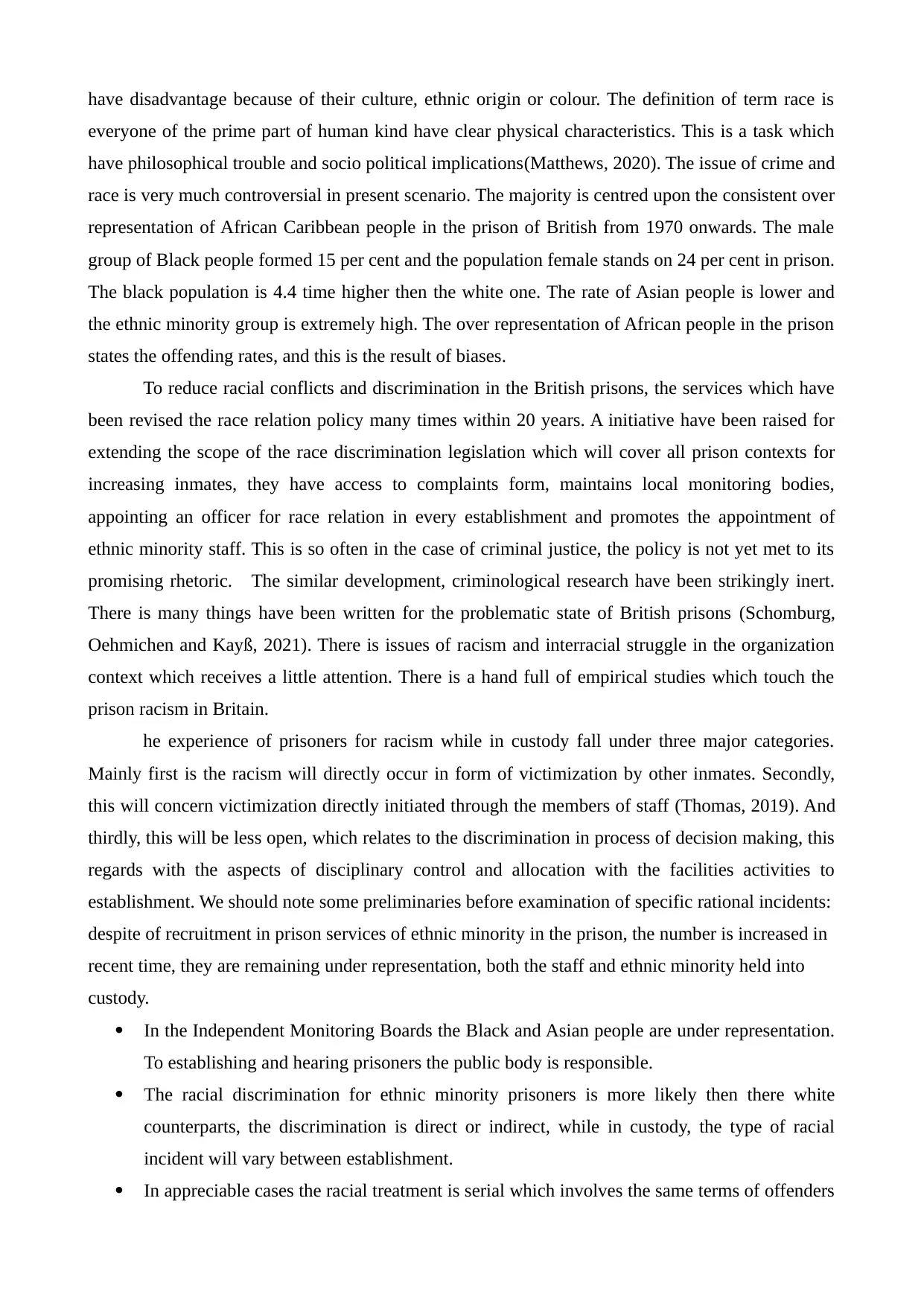
have disadvantage because of their culture, ethnic origin or colour. The definition of term race is
everyone of the prime part of human kind have clear physical characteristics. This is a task which
have philosophical trouble and socio political implications(Matthews, 2020). The issue of crime and
race is very much controversial in present scenario. The majority is centred upon the consistent over
representation of African Caribbean people in the prison of British from 1970 onwards. The male
group of Black people formed 15 per cent and the population female stands on 24 per cent in prison.
The black population is 4.4 time higher then the white one. The rate of Asian people is lower and
the ethnic minority group is extremely high. The over representation of African people in the prison
states the offending rates, and this is the result of biases.
To reduce racial conflicts and discrimination in the British prisons, the services which have
been revised the race relation policy many times within 20 years. A initiative have been raised for
extending the scope of the race discrimination legislation which will cover all prison contexts for
increasing inmates, they have access to complaints form, maintains local monitoring bodies,
appointing an officer for race relation in every establishment and promotes the appointment of
ethnic minority staff. This is so often in the case of criminal justice, the policy is not yet met to its
promising rhetoric. The similar development, criminological research have been strikingly inert.
There is many things have been written for the problematic state of British prisons (Schomburg,
Oehmichen and Kayß, 2021). There is issues of racism and interracial struggle in the organization
context which receives a little attention. There is a hand full of empirical studies which touch the
prison racism in Britain.
he experience of prisoners for racism while in custody fall under three major categories.
Mainly first is the racism will directly occur in form of victimization by other inmates. Secondly,
this will concern victimization directly initiated through the members of staff (Thomas, 2019). And
thirdly, this will be less open, which relates to the discrimination in process of decision making, this
regards with the aspects of disciplinary control and allocation with the facilities activities to
establishment. We should note some preliminaries before examination of specific rational incidents:
despite of recruitment in prison services of ethnic minority in the prison, the number is increased in
recent time, they are remaining under representation, both the staff and ethnic minority held into
custody.
In the Independent Monitoring Boards the Black and Asian people are under representation.
To establishing and hearing prisoners the public body is responsible.
The racial discrimination for ethnic minority prisoners is more likely then there white
counterparts, the discrimination is direct or indirect, while in custody, the type of racial
incident will vary between establishment.
In appreciable cases the racial treatment is serial which involves the same terms of offenders
everyone of the prime part of human kind have clear physical characteristics. This is a task which
have philosophical trouble and socio political implications(Matthews, 2020). The issue of crime and
race is very much controversial in present scenario. The majority is centred upon the consistent over
representation of African Caribbean people in the prison of British from 1970 onwards. The male
group of Black people formed 15 per cent and the population female stands on 24 per cent in prison.
The black population is 4.4 time higher then the white one. The rate of Asian people is lower and
the ethnic minority group is extremely high. The over representation of African people in the prison
states the offending rates, and this is the result of biases.
To reduce racial conflicts and discrimination in the British prisons, the services which have
been revised the race relation policy many times within 20 years. A initiative have been raised for
extending the scope of the race discrimination legislation which will cover all prison contexts for
increasing inmates, they have access to complaints form, maintains local monitoring bodies,
appointing an officer for race relation in every establishment and promotes the appointment of
ethnic minority staff. This is so often in the case of criminal justice, the policy is not yet met to its
promising rhetoric. The similar development, criminological research have been strikingly inert.
There is many things have been written for the problematic state of British prisons (Schomburg,
Oehmichen and Kayß, 2021). There is issues of racism and interracial struggle in the organization
context which receives a little attention. There is a hand full of empirical studies which touch the
prison racism in Britain.
he experience of prisoners for racism while in custody fall under three major categories.
Mainly first is the racism will directly occur in form of victimization by other inmates. Secondly,
this will concern victimization directly initiated through the members of staff (Thomas, 2019). And
thirdly, this will be less open, which relates to the discrimination in process of decision making, this
regards with the aspects of disciplinary control and allocation with the facilities activities to
establishment. We should note some preliminaries before examination of specific rational incidents:
despite of recruitment in prison services of ethnic minority in the prison, the number is increased in
recent time, they are remaining under representation, both the staff and ethnic minority held into
custody.
In the Independent Monitoring Boards the Black and Asian people are under representation.
To establishing and hearing prisoners the public body is responsible.
The racial discrimination for ethnic minority prisoners is more likely then there white
counterparts, the discrimination is direct or indirect, while in custody, the type of racial
incident will vary between establishment.
In appreciable cases the racial treatment is serial which involves the same terms of offenders
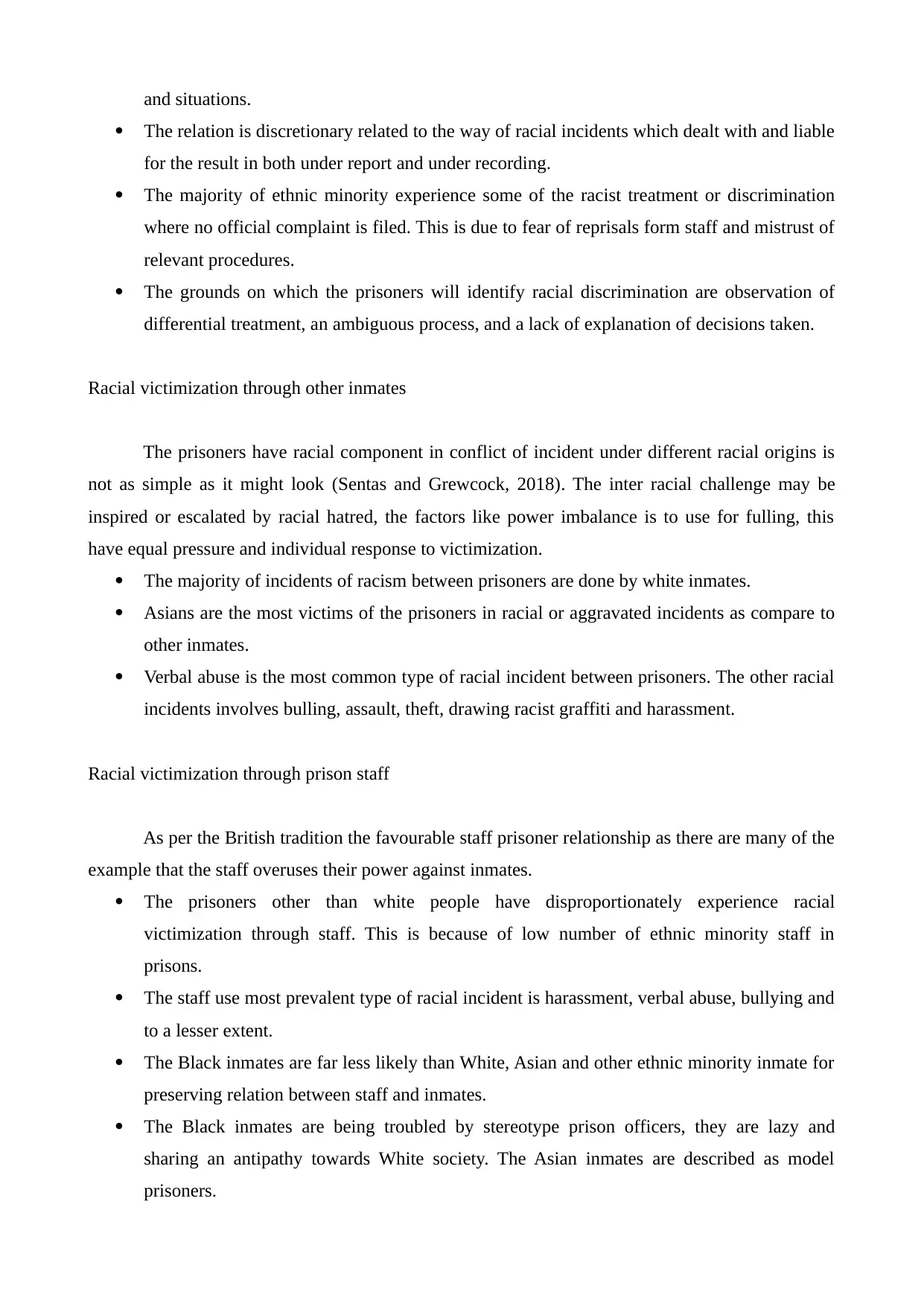
and situations.
The relation is discretionary related to the way of racial incidents which dealt with and liable
for the result in both under report and under recording.
The majority of ethnic minority experience some of the racist treatment or discrimination
where no official complaint is filed. This is due to fear of reprisals form staff and mistrust of
relevant procedures.
The grounds on which the prisoners will identify racial discrimination are observation of
differential treatment, an ambiguous process, and a lack of explanation of decisions taken.
Racial victimization through other inmates
The prisoners have racial component in conflict of incident under different racial origins is
not as simple as it might look (Sentas and Grewcock, 2018). The inter racial challenge may be
inspired or escalated by racial hatred, the factors like power imbalance is to use for fulling, this
have equal pressure and individual response to victimization.
The majority of incidents of racism between prisoners are done by white inmates.
Asians are the most victims of the prisoners in racial or aggravated incidents as compare to
other inmates.
Verbal abuse is the most common type of racial incident between prisoners. The other racial
incidents involves bulling, assault, theft, drawing racist graffiti and harassment.
Racial victimization through prison staff
As per the British tradition the favourable staff prisoner relationship as there are many of the
example that the staff overuses their power against inmates.
The prisoners other than white people have disproportionately experience racial
victimization through staff. This is because of low number of ethnic minority staff in
prisons.
The staff use most prevalent type of racial incident is harassment, verbal abuse, bullying and
to a lesser extent.
The Black inmates are far less likely than White, Asian and other ethnic minority inmate for
preserving relation between staff and inmates.
The Black inmates are being troubled by stereotype prison officers, they are lazy and
sharing an antipathy towards White society. The Asian inmates are described as model
prisoners.
The relation is discretionary related to the way of racial incidents which dealt with and liable
for the result in both under report and under recording.
The majority of ethnic minority experience some of the racist treatment or discrimination
where no official complaint is filed. This is due to fear of reprisals form staff and mistrust of
relevant procedures.
The grounds on which the prisoners will identify racial discrimination are observation of
differential treatment, an ambiguous process, and a lack of explanation of decisions taken.
Racial victimization through other inmates
The prisoners have racial component in conflict of incident under different racial origins is
not as simple as it might look (Sentas and Grewcock, 2018). The inter racial challenge may be
inspired or escalated by racial hatred, the factors like power imbalance is to use for fulling, this
have equal pressure and individual response to victimization.
The majority of incidents of racism between prisoners are done by white inmates.
Asians are the most victims of the prisoners in racial or aggravated incidents as compare to
other inmates.
Verbal abuse is the most common type of racial incident between prisoners. The other racial
incidents involves bulling, assault, theft, drawing racist graffiti and harassment.
Racial victimization through prison staff
As per the British tradition the favourable staff prisoner relationship as there are many of the
example that the staff overuses their power against inmates.
The prisoners other than white people have disproportionately experience racial
victimization through staff. This is because of low number of ethnic minority staff in
prisons.
The staff use most prevalent type of racial incident is harassment, verbal abuse, bullying and
to a lesser extent.
The Black inmates are far less likely than White, Asian and other ethnic minority inmate for
preserving relation between staff and inmates.
The Black inmates are being troubled by stereotype prison officers, they are lazy and
sharing an antipathy towards White society. The Asian inmates are described as model
prisoners.
⊘ This is a preview!⊘
Do you want full access?
Subscribe today to unlock all pages.

Trusted by 1+ million students worldwide
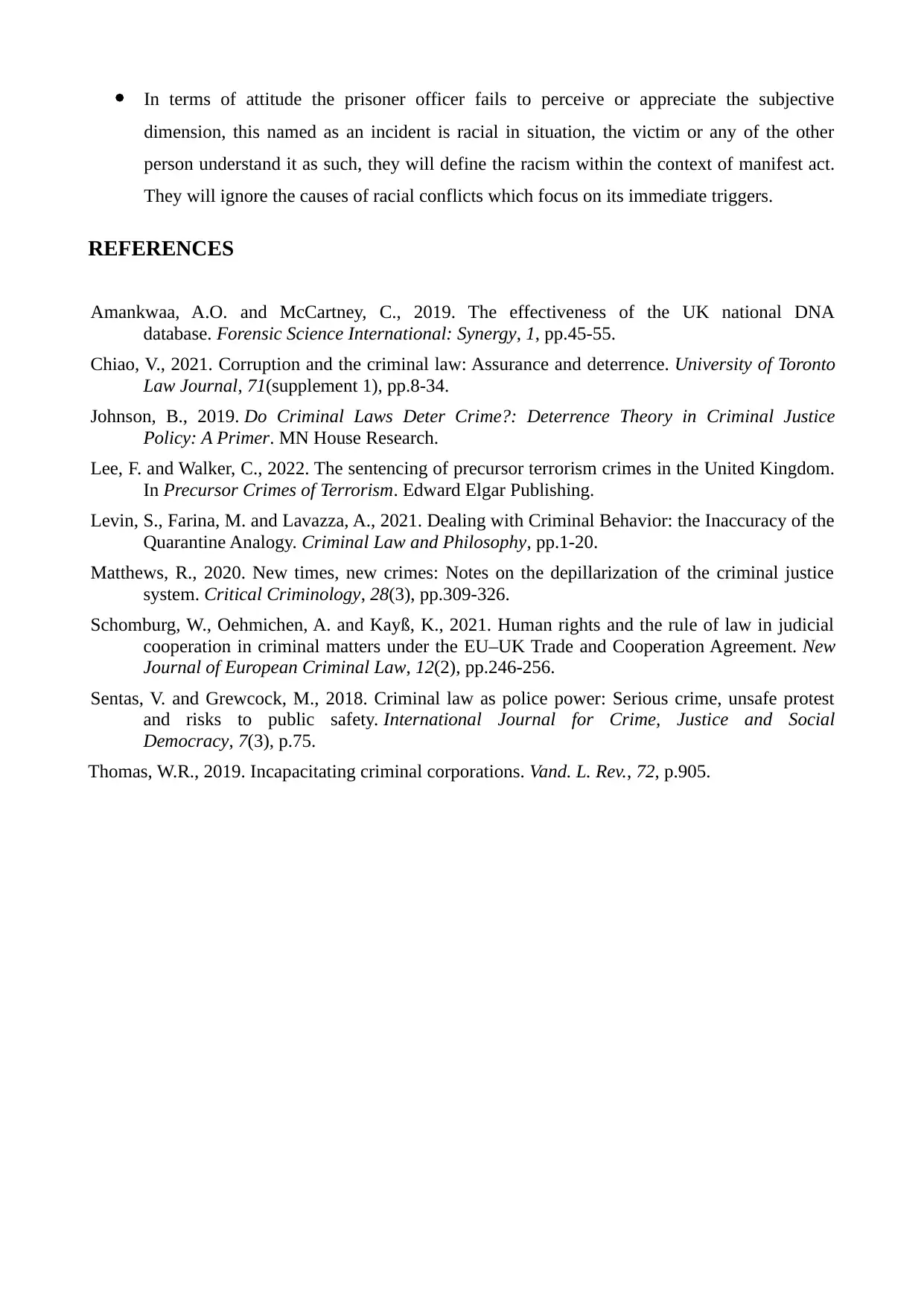
In terms of attitude the prisoner officer fails to perceive or appreciate the subjective
dimension, this named as an incident is racial in situation, the victim or any of the other
person understand it as such, they will define the racism within the context of manifest act.
They will ignore the causes of racial conflicts which focus on its immediate triggers.
REFERENCES
Amankwaa, A.O. and McCartney, C., 2019. The effectiveness of the UK national DNA
database. Forensic Science International: Synergy, 1, pp.45-55.
Chiao, V., 2021. Corruption and the criminal law: Assurance and deterrence. University of Toronto
Law Journal, 71(supplement 1), pp.8-34.
Johnson, B., 2019. Do Criminal Laws Deter Crime?: Deterrence Theory in Criminal Justice
Policy: A Primer. MN House Research.
Lee, F. and Walker, C., 2022. The sentencing of precursor terrorism crimes in the United Kingdom.
In Precursor Crimes of Terrorism. Edward Elgar Publishing.
Levin, S., Farina, M. and Lavazza, A., 2021. Dealing with Criminal Behavior: the Inaccuracy of the
Quarantine Analogy. Criminal Law and Philosophy, pp.1-20.
Matthews, R., 2020. New times, new crimes: Notes on the depillarization of the criminal justice
system. Critical Criminology, 28(3), pp.309-326.
Schomburg, W., Oehmichen, A. and Kayß, K., 2021. Human rights and the rule of law in judicial
cooperation in criminal matters under the EU–UK Trade and Cooperation Agreement. New
Journal of European Criminal Law, 12(2), pp.246-256.
Sentas, V. and Grewcock, M., 2018. Criminal law as police power: Serious crime, unsafe protest
and risks to public safety. International Journal for Crime, Justice and Social
Democracy, 7(3), p.75.
Thomas, W.R., 2019. Incapacitating criminal corporations. Vand. L. Rev., 72, p.905.
dimension, this named as an incident is racial in situation, the victim or any of the other
person understand it as such, they will define the racism within the context of manifest act.
They will ignore the causes of racial conflicts which focus on its immediate triggers.
REFERENCES
Amankwaa, A.O. and McCartney, C., 2019. The effectiveness of the UK national DNA
database. Forensic Science International: Synergy, 1, pp.45-55.
Chiao, V., 2021. Corruption and the criminal law: Assurance and deterrence. University of Toronto
Law Journal, 71(supplement 1), pp.8-34.
Johnson, B., 2019. Do Criminal Laws Deter Crime?: Deterrence Theory in Criminal Justice
Policy: A Primer. MN House Research.
Lee, F. and Walker, C., 2022. The sentencing of precursor terrorism crimes in the United Kingdom.
In Precursor Crimes of Terrorism. Edward Elgar Publishing.
Levin, S., Farina, M. and Lavazza, A., 2021. Dealing with Criminal Behavior: the Inaccuracy of the
Quarantine Analogy. Criminal Law and Philosophy, pp.1-20.
Matthews, R., 2020. New times, new crimes: Notes on the depillarization of the criminal justice
system. Critical Criminology, 28(3), pp.309-326.
Schomburg, W., Oehmichen, A. and Kayß, K., 2021. Human rights and the rule of law in judicial
cooperation in criminal matters under the EU–UK Trade and Cooperation Agreement. New
Journal of European Criminal Law, 12(2), pp.246-256.
Sentas, V. and Grewcock, M., 2018. Criminal law as police power: Serious crime, unsafe protest
and risks to public safety. International Journal for Crime, Justice and Social
Democracy, 7(3), p.75.
Thomas, W.R., 2019. Incapacitating criminal corporations. Vand. L. Rev., 72, p.905.
1 out of 7
Related Documents
Your All-in-One AI-Powered Toolkit for Academic Success.
+13062052269
info@desklib.com
Available 24*7 on WhatsApp / Email
![[object Object]](/_next/static/media/star-bottom.7253800d.svg)
Unlock your academic potential
Copyright © 2020–2025 A2Z Services. All Rights Reserved. Developed and managed by ZUCOL.





